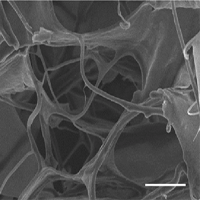 Smart Citations
Smart CitationsSee how this article has been cited at scite.ai
scite shows how a scientific paper has been cited by providing the context of the citation, a classification describing whether it supports, mentions, or contrasts the cited claim, and a label indicating in which section the citation was made.
Development of nanostructured bioplastic material for wound healing
The development of new biomaterials whose characteristics are as close as possible to the properties of living human tissues is one of the most promising areas of regenerative medicine. This work aimed at creating a bioplastic material based on collagen, elastin and hyaluronic acid and studying its structure and properties to assess the prospects for further use in clinical practice. Bioplastic material was obtained by mixing collagen, hyaluronic acid and elastin in predetermined proportions with distilled water. We treated the material with photochemical crosslinking to stabilize biofilm in a liquid medium and form a nanostructured scaffold. A commercial human skin fibroblast cell culture was used to assess the biomaterial cytotoxicity and biocompatibility. The visualization and studies of the biomaterial structure were performed using light and scanning electron microscopy. It has been shown that the obtained biomaterial is characterized by high resilience; it has also a high porosity. The co-culturing of the bioplastic material and human fibroblasts did not reveal any of its cytotoxic effects on cells in culture. It was shown that the biomaterial samples could maintain physical properties in the culture medium for more than 10 days, while the destruction of the matrix was observed 3–4 weeks after the beginning of incubation. Thus, the created biomaterial can be used on damaged skin areas due to its physical properties and structure. The use of the developed biomaterial provides effective conditions for good cell proliferation, which allows us to consider it as a promising wound cover for use in clinical practice.
Downloads
How to Cite
PAGEPress has chosen to apply the Creative Commons Attribution NonCommercial 4.0 International License (CC BY-NC 4.0) to all manuscripts to be published.

 https://doi.org/10.4081/ejtm.2021.9388
https://doi.org/10.4081/ejtm.2021.9388





